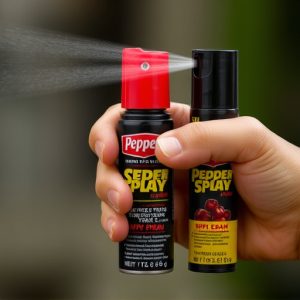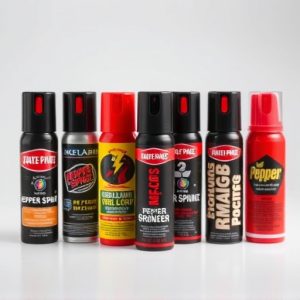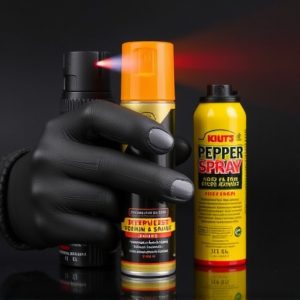Decoding Pepper Spray Costs: Market Dynamics & Manufacturer Strategies
Pepper spray pricing is influenced by a complex interplay of factors, with manufacturers balancing …….
Pepper spray pricing is influenced by a complex interplay of factors, with manufacturers balancing input costs for raw materials like capsaicinoids and additional features such as UV dyes or keychain attachments against the need to comply with safety standards and obtain certifications. These factors, along with market demand, production scale, competition dynamics, and supply chain efficiencies, collectively shape the cost structure and pricing strategies of pepper spray products. Wholesale prices are lower for bulk buyers due to economies of scale, while retail prices are affected by packaging, brand recognition, marketing, and distribution channels. High-quality pepper sprays with advanced formulations and safety certifications command higher prices due to their superior efficacy and reliability. Manufacturers employ dynamic pricing models to stay competitive, adjusting prices in real-time based on market trends and competitor actions. Brand reputation also influences pricing, with well-established brands typically charging more for their products. Understanding these factors helps stakeholders anticipate market shifts and adapt accordingly, ensuring pepper spray products are positioned effectively in the marketplace.
When considering the cost of personal defense tools, pepper spray emerges as a widely utilized deterrent. The pricing landscape for these self-defense sprays is shaped by several factors, from raw material costs to safety certifications. This article delves into the market dynamics governing pepper spray prices, examining how manufacturers like ourselves navigate price points, and how product features, quality, and regulatory compliance influence the final cost. We’ll analyze the variations in wholesale and retail prices across manufacturers and provide insights into strategic pricing models that ensure competitive yet fair pricing for this critical safety product.
Understanding the Market Dynamics of Pepper Spray Pricing
The market dynamics for pepper spray pricing are influenced by a variety of factors, chief among which are the practices and strategies of pepper spray manufacturers. These entities operate at different scales, from small-scale artisanal producers to large industrial conglomerates, each impacting the supply chain and, consequently, the cost of pepper spray products. The input costs for manufacturing pepper spray include raw materials such as capsaicinoids—the active ingredient derived from chili peppers—along with the containers, propellants, and any additional features like UV dyes or keychain attachments. Variations in these inputs can lead to fluctuations in pricing.
Furthermore, market dynamics are also shaped by regulatory compliance costs, research and development investments, and the competitive landscape. Manufacturers must adhere to stringent safety standards and obtain certifications that can be both time-consuming and costly. Additionally, as pepper spray gains popularity for self-defense and law enforcement, demand may outstrip supply, particularly for certain formulations or branded products. This dynamic can lead to price increases if manufacturers opt to capitalize on the higher demand. Conversely, in a saturated market with high competition, manufacturers might engage in cost-saving measures to maintain competitiveness, potentially leading to more affordable pepper spray options for consumers. Understanding these market dynamics requires a thorough analysis of supply chain efficiencies, regulatory hurdles, competitive positioning, and consumer demand trends—all of which can influence the final price point of pepper spray products in the marketplace.
Factors Influencing the Cost Structure of Pepper Spray Products
The cost structure of pepper spray products is influenced by a multitude of factors, each playing a critical role in the final price point. One significant determinant is the sourcing of raw materials. High-quality peppers, primarily capsaicin, are essential for effective formulations, and their cost can fluctuate based on crop yields and market demand. Manufacturers must navigate these variables to maintain consistent product quality without prohibitive price increases. Additionally, the manufacturing process itself is a substantial factor in pricing. Advanced techniques and specialized equipment can elevate production costs, yet they ensure safety, efficacy, and compliance with regulatory standards.
Pepper spray manufacturers that invest in research and development to innovate and improve their products may pass these costs onto consumers, but this investment also ensures a competitive edge in the market. Furthermore, operational overheads, including labor, facility maintenance, and distribution logistics, contribute to the cost structure. Economies of scale also come into play; larger manufacturers with higher production volumes can optimize costs more effectively than smaller producers, potentially allowing them to offer more competitively priced products. Lastly, market dynamics such as demand, competition, and consumer preferences influence pricing strategies, making the pepper spray market a complex landscape where cost, quality, and availability are in constant interplay.
Analysis of Wholesale and Retail Price Variations Among Pepper Spray Manufacturers
The market dynamics for pepper spray reveal a nuanced interplay between wholesale and retail price points across various pepper spray manufacturers. Wholesale pricing strategies often reflect bulk purchase considerations, with costs per unit typically lower than their retail counterparts. This cost-saving measure is designed to attract security firms, law enforcement agencies, and educational institutions that require large quantities of self-defense products for their staff or students. As these bulk purchases are essential for the aforementioned entities to fulfill their safety mandates, manufacturers often offer competitive wholesale rates.
In contrast, retail prices for pepper spray are subject to additional factors such as packaging, brand recognition, and distribution channels. Consumer-focused manufacturers may incorporate higher margins into their retail pricing to account for marketing expenses and to ensure a return on investment despite the lower volume of sales compared to wholesale transactions. Furthermore, regional demand and supply dynamics can influence price fluctuations at the retail level, with areas experiencing heightened interest or scarcity potentially seeing an uptick in cost. Consequently, consumers should be aware that the price they pay for pepper spray at the point of purchase is influenced by a multitude of factors beyond just production costs, including brand positioning and market saturation. Understanding these variations can help buyers make informed decisions when procuring self-defense products from various pepper spray manufacturers.
The Role of Quality, Features, and Safety Certifications in Determining Pepper Spray Prices
The efficacy and quality of pepper spray products play a pivotal role in influencing their market prices. High-quality pepper sprays, manufactured with precision and adherence to stringent industry standards, command higher price points. These products often feature advanced formulations that ensure greater effectiveness, accuracy, and safety upon deployment. The composition of the pepper spray, including the potency of the active ingredient capsaicin, contributes to its price; stronger concentrations typically cost more due to the rigorous research and development required to achieve optimal performance.
In addition to the quality of the product itself, safety certifications are a critical factor that affects pricing. Pepper spray manufacturers that secure certifications from reputable organizations demonstrate compliance with safety regulations and standards. These certifications serve as testaments to the reliability and efficacy of their products. Consumers are more likely to invest in pepper spray that has undergone extensive testing and meets all necessary legal and safety requirements, which is reflected in the price. As a result, products from manufacturers with these credentials tend to be priced higher than those without such certifications, reflecting the added value and trustworthiness they offer.
Strategic Overview: How Pepper Spray Manufacturers Set Competitive Prices
In a competitive market, pepper spray manufacturers employ various strategies to set prices that both reflect the value of their products and remain attractive to consumers. These strategic pricing approaches consider production costs, market demand, competitor pricing, and regulatory compliance. Manufacturers analyze the cost of raw materials, research and development, labor, and overhead to establish a base price point. They then assess market trends and consumer purchasing power to ensure their pricing aligns with the perceived value of the product. Additionally, they monitor competitors’ pricing structures, often employing dynamic pricing models that allow for real-time adjustments based on market shifts and sales performance. This ensures pepper spray manufacturers can maintain a competitive edge while adhering to industry standards and legal regulations. Furthermore, they consider the brand positioning within the market, with high-quality, reputable brands typically commanding higher prices compared to generic alternatives. By meticulously balancing these factors, pepper spray manufacturers aim to optimize their pricing strategy, ensuring both profitability and customer satisfaction.


